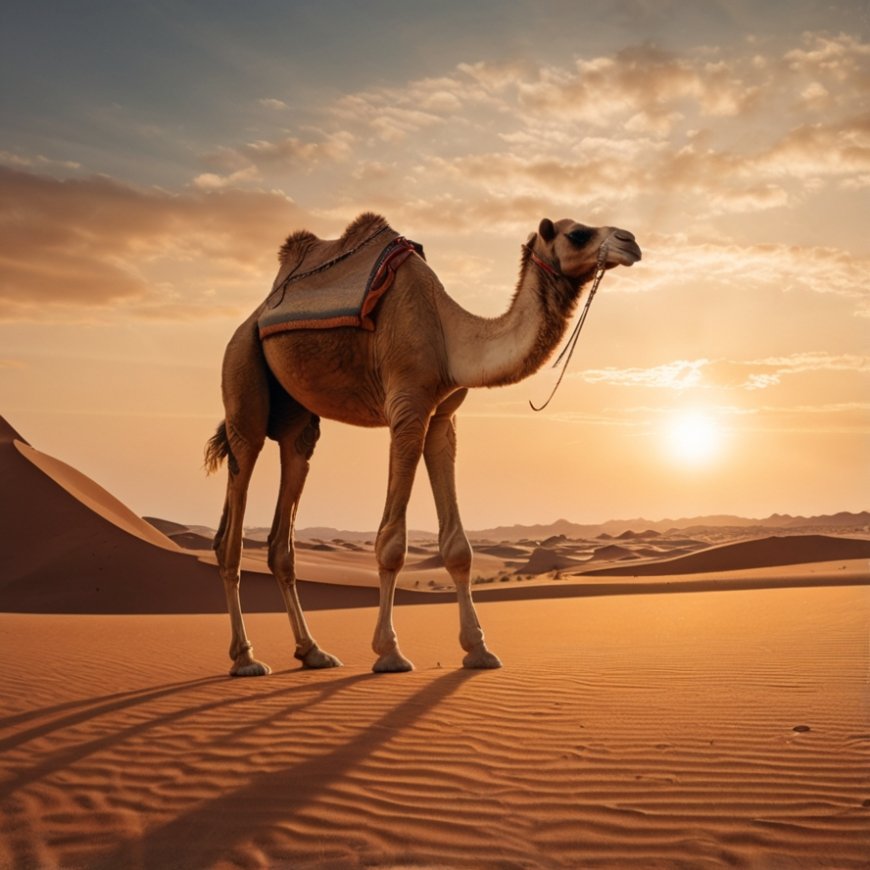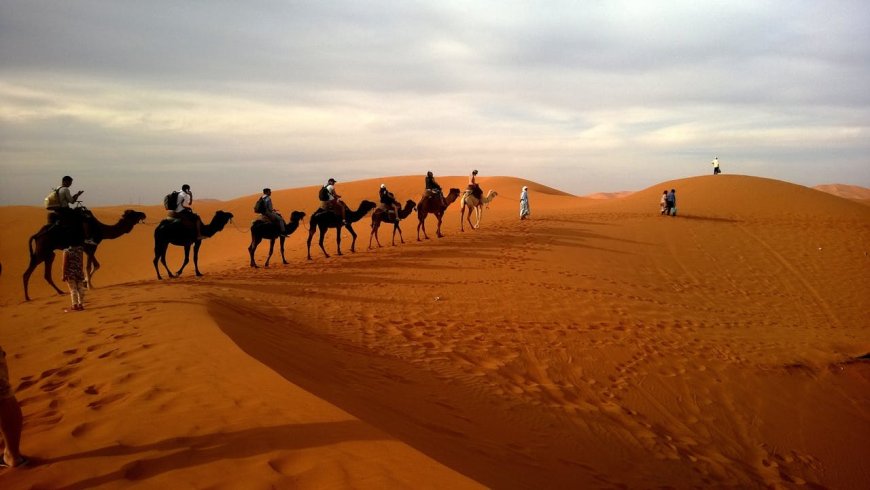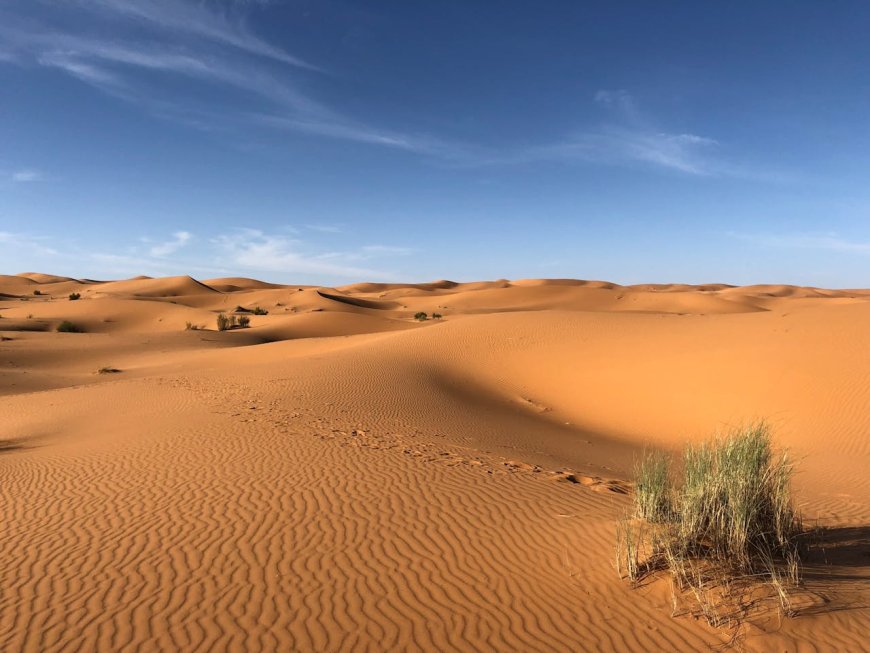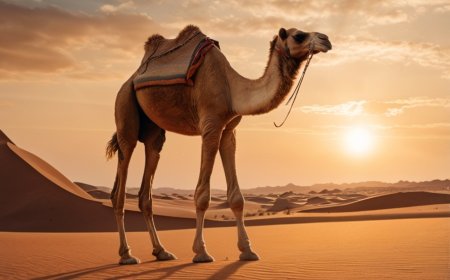Crucial role of Sahara desert
The Sahara Desert is the world’s largest hot desert, covering much of North Africa across more than ten countries. It spans about 9.2 million square kilometers, roughly the size of the United States. Known for its extreme climate, the Sahara experiences scorching daytime temperatures that can rise above 50°C (122°F) and very little rainfall, making it one of the driest places on Earth.

The landscape is diverse, featuring massive sand dunes, rocky plateaus, gravel plains, and occasional mountains. Despite the harsh conditions, the Sahara is home to specially adapted plants and animals, as well as nomadic peoples like the Tuareg who have lived there for centuries.
The desert has played a crucial role in history as a barrier and a trade route linking various African and Mediterranean cultures. It continues to be a place of natural wonder and scientific interest today.
Location:
Northern Africa, stretching across 11 countries (Algeria, Chad, Egypt, Libya, Mali, Mauritania, Morocco, Niger, Sudan, Tunisia, and Western Sahara).
Size:
About 9.2 million square kilometers (3.6 million square miles), making it the largest hot desert in the world and the third largest desert overall after Antarctica and the Arctic (which are cold deserts).
Climate:
-
Extremely arid with very low rainfall (less than 25 mm or 1 inch per year in many areas).
-
Temperatures can soar above 50°C (122°F) during the day and drop sharply at night, sometimes below freezing in winter.
-
Known for intense heat and dryness, with vast areas of sand dunes, gravel plains, and rocky plateaus.
Geography and Landscape:
-
The desert is not just endless sand dunes; it includes gravel plains (regs), rocky plateaus (hamadas), salt flats, and scattered mountains.
-
Famous dune fields include the Erg Chebbi and Erg Chigaga in Morocco.
-
Key mountain ranges include the Ahaggar Mountains (Hoggar) and Tibesti Mountains.
Flora and Fauna:
-
Sparse vegetation mainly consists of drought-resistant shrubs, grasses, and some acacia trees near oases.
-
Wildlife includes reptiles, rodents, foxes (fennec fox), camels, and various birds adapted to desert life.
Human Inhabitants:
-
Traditionally inhabited by nomadic peoples such as the Tuareg and Bedouin.
-
Many live near oases where water supports agriculture and settlements.
-
Modern cities exist on the desert edges or in oases, like Timbuktu (Mali), Ghat (Libya), and Erfoud (Morocco).
Significance:
-
The Sahara has a rich history of ancient civilizations and trade routes, especially for gold, salt, and spices.
-
Contains important archaeological sites with prehistoric rock art and fossils.
-
Its extreme environment makes it a focus for climate and environmental studies.

Geographical Features
The Sahara is bordered by the Atlantic Ocean to the west, the Atlas Mountains and Mediterranean Sea to the north, the Red Sea to the east, and the semi-arid Sahel region to the south. Its immense size (approximately 9.2 million square kilometers, comparable to China or the USA) encompasses parts of eleven countries: Algeria, Chad, Egypt, Libya, Mali, Mauritania, Morocco, Niger, Sudan, Tunisia, and Western Sahara.
Despite popular imagery, only about 25% of the Sahara is covered by sand dunes and sand seas (known as ergs). The majority of its surface consists of:
- Hammadas: Extensive, barren, rocky plateaus.
- Regs (Serirs): Flat, gravel-covered plains.
- Chotts and Dayas: Shallow, seasonally inundated basins and large oasis depressions.
- Mountains: Abrupt and often volcanic mountain ranges punctuate the desert's monotony. Notable ranges include the Tibesti Mountains (home to Mount Koussi, the Sahara's highest peak at 3,415 meters), the Ahaggar Mountains, the Aïr Massif, and the Adrar des Iforas.
- Dry Valleys (Wadis) and Dry Lakes (Oueds): These are remnants of ancient river systems, occasionally filling with water after rare rainfall.
- Salt Flats (Shatts or Chotts): Areas where water has evaporated, leaving behind salt deposits.
The Sahara also contains over 20 lakes, almost all of which are saltwater, with Lake Chad being the only significant freshwater lake. An unusual landform is the Richat Structure in Mauritania, a prominent circular geological feature resembling an enormous bull's-eye.
Climate
The Sahara is defined by its hyper-arid to arid climate, characterized by extremely low rainfall and wide temperature variations. Two main climatic regimes dominate:
- Dry Subtropical Climate (Northern Sahara): Features cold to cool winters and hot summers, with large daily and annual temperature ranges. Precipitation is scarce, averaging around 76 mm (3 inches) per year, with two maximums: December to March and a lesser one in August (often characterized by flash floods from thunderstorms). Occasional snowfall can occur on northern plateaus. Hot, dust-laden southerly winds like the khamsin (Egypt), ghibli (Libya), and chili (Tunisia) are common, especially in spring.
- Dry Tropical Climate (Southern Sahara): Experiences mild, dry winters and a hot, dry season before variable summer rains, influenced by the Intertropical Convergence Zone. Average temperatures for the coldest months are similar to the north, but daily ranges are more moderate. High temperatures can reach 50°C (122°F). Precipitation averages about 127 mm (5 inches) per year, primarily from summer thunderstorms. The harmattan, a dry northeasterly wind, is prevalent in winter.
Overall, more than half of the Sahara is virtually rainless, with many consecutive years passing without any precipitation. Temperatures can soar above 40°C (104°F) for months, with the highest recorded temperature being 58°C (136°F) in El Azizia, Libya. However, due to the lack of humidity, temperatures can drop dramatically at night, sometimes reaching below freezing.
Biodiversity
Despite its harsh conditions, the Sahara supports a surprising array of life, though biomass is generally lower than in other biomes. Species found here possess remarkable adaptations to heat and aridity.
- Flora: Approximately 500 species of plants, primarily xerophytes, have adapted to survive. These include acacia trees, date palms (around oases), succulents, spiny shrubs, and drought-tolerant grasses and herbs. Adaptations include deep root systems, waxy cuticles to reduce water loss, and the ability to rapidly grow and flower after rare rainfall.
- Fauna: The Sahara is home to around 70 species of mammals, 300 species of birds, 100 species of reptiles, and numerous species of spiders and scorpions. Iconic animals include:
- Mammals: Dromedary camels (introduced and widely used), fennec foxes (the smallest canid), addax antelopes (critically endangered), slender-horned gazelles, Dorcas gazelles, Saharan cheetahs, and various rodents.
- Reptiles: Lizards (like monitor lizards), snakes, and tortoises.
- Birds: Ostriches, various raptors, and migratory birds.
- Arthropods: Scorpions, spiders, and desert ants. Biodiversity increases significantly near oases and seasonally wet areas where groundwater is available.
Human History and Culture
The Sahara has a rich human history, far from being an empty wasteland. Archaeological evidence, including stone artifacts, fossils, and extensive rock art, reveals that the Sahara was once a lush, green savanna with abundant water and diverse wildlife during periods like the African Humid Period (roughly 14,500 to 4,500 years ago). Ancient cultures thrived, with evidence of hunter-gatherers (like the Kiffian culture, known for barbed bone harpoons), early pastoralists herding cattle, and later the introduction of sheep, goats, and finally camels, which became crucial for trans-Saharan trade.
Today, the Sahara is home to about two million people, predominantly nomadic or semi-nomadic groups, as well as those living in sedentary communities around oases.
- Nomadic Peoples: Groups like the Tuareg (often called the "blue people" due to their indigo veils), Fulani, Regeibat, and Chaamba have historically adapted to the desert environment through pastoralism (herding camels, sheep, and goats) and seasonal migrations (transhumance). They developed unique skills for survival and navigating the vast desert.
- Oasis Dwellers: Sedentary populations are concentrated in oases, where irrigation allows for cultivation of date palms, various fruits, cereals (millet, barley, wheat), and vegetables. Oasis towns like Timbuktu and Ghardaia became vital centers of trade and civilization, providing refuge and resources for travelers.
- Trans-Saharan Trade: For millennia, the Sahara has been crisscrossed by ancient trade routes connecting North Africa with sub-Saharan Africa. Ancient civilizations like the Egyptians and Carthaginians, and later the Ghana, Mali, and Songhai Empires, grew wealthy from the exchange of commodities like gold, salt, ivory, and slaves. The introduction of camels around the 3rd century CE significantly boosted this trade.
- Culture: Desert cultures are often characterized by resilience, resourcefulness, and strong community ties. Islamic influence is widespread, shaping architecture, language, and religious practices. Traditional arts, such as Tuareg silver jewelry, are often simple in form but rich in cultural significance.

The Sahara Desert, the world's largest hot desert, is a vast and awe-inspiring expanse covering much of North Africa. Far from being a monolithic sea of sand, it's a diverse landscape of extremes, shaped by ancient geological forces and harsh climatic conditions.Despite modernization and some mineral exploitation (oil, gas, uranium), the traditional nomadic lifestyle faces challenges due to changing economic conditions and government policies promoting settlement. Desertification and climate change also pose significant threats to sustainable human habitation in the region.
What's Your Reaction?
 Like
0
Like
0
 Dislike
0
Dislike
0
 Love
0
Love
0
 Funny
0
Funny
0
 Angry
0
Angry
0
 Sad
0
Sad
0
 Wow
0
Wow
0



























